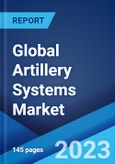The global artillery systems market size reached US$ 4.1 Billion in 2022. Looking forward, the market is expected to reach US$ 5.1 Billion by 2028, exhibiting a growth rate (CAGR) of 3.70% during 2022-2028.
Artillery systems are weapons and arms used by military forces for high strategic and tactical mobility. Mortars, multiple launch rocket systems (MLRS), howitzers, air defense guns, man-portable air-defense systems (MANPADS) and rocket artillery are some commonly used artillery systems. They are used for providing fire support to the arms in combat, attacking targets and neutralizing gun emplacements of the enemy forces. In comparison to the traditionally used artillery weapons, artillery systems offer enhanced accuracy, precise firepower, rapid response and reduced reload time. As a result, they are extensively used across military and defense industries.
Artillery systems are weapons and arms used by military forces for high strategic and tactical mobility. Mortars, multiple launch rocket systems (MLRS), howitzers, air defense guns, man-portable air-defense systems (MANPADS) and rocket artillery are some commonly used artillery systems. They are used for providing fire support to the arms in combat, attacking targets and neutralizing gun emplacements of the enemy forces. In comparison to the traditionally used artillery weapons, artillery systems offer enhanced accuracy, precise firepower, rapid response and reduced reload time. As a result, they are extensively used across military and defense industries.
Artillery Systems Market Trends
An alarming increase in armed conflicts, violence and terrorism across the globe is one of the key factors driving the growth of the market. Artillery systems are widely adopted to improve national security and provide protection against fast-moving objects. These systems are also utilized by land, air and naval forces during training for war. Moreover, the increasing adoption of the single barrel weapon system is providing a thrust to the market growth. These systems are lighter, cost-effective and can fire rapid successive shots. Additionally, various product innovations, such as the development of mobile, lightweight and self-propelled artillery systems, are favoring the market growth. They are used for long-range indirect fire support on the battlefield and can be brought into action much faster. In line with this, the increasing demand for howitzers in place of field guns and cannons to attack targets using indirect and direct fire is positively impacting the market growth. Other factors, including the increasing demand for advanced weapon machinery by ground defense services, along with rising defense expenditures, are anticipated to drive the market toward growth.Key Market Segmentation
This research provides an analysis of the key trends in each sub-segment of the global artillery systems market report, along with forecasts at the global, regional and country level from 2023-2028. The report has categorized the market based on type, component, caliber, range and end user.Breakup by Type:
- Rocket
- Anti-air
- Howitzer
- Mortar
Breakup by Component:
- Fire Control System
- Chassis
- Engine
- Gun Turret
Breakup by Caliber:
- Small
- Medium
- Heavy
Breakup by Range:
- Short-range
- Medium range
- Long-range
Breakup by End User:
- Aerospace and Defense
- Homeland Security
Breakup by Region:
- North America
- United States
- Canada
- Asia-Pacific
- China
- Japan
- India
- South Korea
- Australia
- Indonesia
- Europe
- Germany
- France
- United Kingdom
- Italy
- Spain
- Russia
- Latin America
- Brazil
- Mexico
- Middle East and Africa
Competitive Landscape
The competitive landscape of the industry has also been examined along with the profiles of the key players being Avibras Industria Aeroespacial, BAE Systems plc, Denel Soc Ltd, Elbit Systems Ltd., General Dynamics Corporation, Hanwha Group, Leonardo SpA, Lockheed Martin Corporation, Nexter group KNDS, Rostec, RUAG Holding and Singapore Technologies Engineering.Key Questions Answered in This Report:
- How has the global artillery systems market performed so far and how will it perform in the coming years?
- What has been the impact of COVID-19 on the global artillery systems market?
- What are the key regional markets?
- What is the breakup of the market based on the type?
- What is the breakup of the market based on the component?
- What is the breakup of the market based on the caliber?
- What is the breakup of the market based on the range?
- What is the breakup of the market based on the end user?
- What are the various stages in the value chain of the industry?
- What are the key driving factors and challenges in the industry?
- What is the structure of the global artillery systems market and who are the key players?
- What is the degree of competition in the industry?
Table of Contents
1 Preface3 Executive Summary13 Value Chain Analysis15 Price Analysis
2 Scope and Methodology
4 Introduction
5 Global Artillery Systems Market
6 Market Breakup by Type
7 Market Breakup by Component
8 Market Breakup by Caliber
9 Market Breakup by Range
10 Market Breakup by End User
11 Market Breakup by Region
12 SWOT Analysis
14 Porters Five Forces Analysis
16 Competitive Landscape
Companies Mentioned
- Avibras Industria Aeroespacial
- BAE Systems plc
- Denel Soc Ltd
- Elbit Systems Ltd.
- General Dynamics Corporation
- Hanwha Group
- Leonardo SpA
- Lockheed Martin Corporation
- Nexter group KNDS
- Rostec
- RUAG Holding
- Singapore Technologies Engineering
Methodology

LOADING...
Table Information
| Report Attribute | Details |
|---|---|
| No. of Pages | 145 |
| Published | November 2023 |
| Forecast Period | 2022 - 2028 |
| Estimated Market Value ( USD | $ 4.1 Billion |
| Forecasted Market Value ( USD | $ 5.1 Billion |
| Compound Annual Growth Rate | 3.7% |
| Regions Covered | Global |
| No. of Companies Mentioned | 12 |








